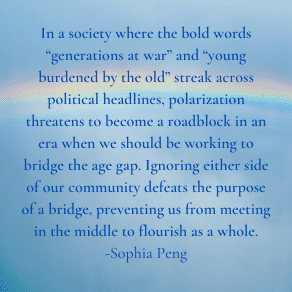
When I first started playing violin, I began by learning the names and functions of each part of the delicate instrument. As a second-grader, the memorization was a daunting task; the only part of the instrument I could consistently recall was the bridge: a small, curved piece of wood whose function is to hold the tension of all four strings. Without the bridge, producing a rich, tonal quality is impossible, rendering the instrument useless. As I matured and began to develop a worldview encompassing more than the physical aspects of life and music, I drew connections between the pieces I saw on my instrument and the society I lived in. Still, it wasn’t until I stepped foot in my community nursing home that I realized the importance of bridges in a society that is becoming increasingly polarized by a widening generational gap.
In 2015, I leapt into a journey of self-discovery and communal awareness as I stepped through the door of Heritage Senior Home with my violin case in hand. While my first day of performing for the senior citizens was nerve-wracking to start, I felt my tensions ease as the residents smiled and applauded each piece I played, regardless of whether or not I felt I had performed well. I returned week after week to spend an hour with the residents, 60 minutes each week that felt like 60 seconds. As classic hymnals and timeless songs escaped my violin, I found myself traversing age barriers and forming deep connections with the residents. Even the most reserved seniors transformed into an enthusiastic chorale, singing along to “Oh, You Beautiful Doll.” The short but sweet exchanges of weekly stories after each “concert” cultivated a unique atmosphere where my role was not to be a performer, but a listener and a companion.
Similar to how the bridge on my violin anchors each string down and serves as a connection point between the fingerboard and tailpiece, the hypothetical bridge I traversed through 5 years of music with my Heritage family allowed me to connect with people whom I had never expected to call my friends. I learned that there are always two sides to a bridge, and while they may appear vastly different on the outside, they ultimately share the same purpose of connection. In a society where the bold words “generations at war” and “young burdened by the old” streak across political headlines, polarization threatens to become a roadblock in an era when we should be working to bridge the age gap. Ignoring either side of our community defeats the purpose of a bridge, preventing us from meeting in the middle to flourish as a whole. As a teenager living in the midst of one of the most severe generational gaps in history, I embrace the fact that my way of life is not the only way, that my life experiences are not mutually exclusive and absolute, and that there is much to learn from the other side.
As I journey from high school to college, I hope to inspire and aid in creating a program where ensembles venture beyond campus to cross bridges and form communities of their own through music, in nursing homes and beyond. Sharing experiences with others through music is something I want to hold onto even as I move onto this next chapter in my life. If a tiny piece of wood can hold together an entire instrument, then one person can make a difference in the lives of many. It is simply up to us to take the first steps across the bridge.
